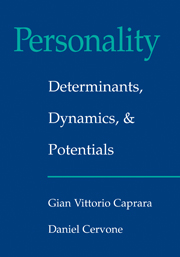Book contents
- Frontmatter
- Contents
- Preface
- PART ONE INTRODUCTION TO PERSONALITY PSYCHOLOGY
- PART TWO DESCRIPTION AND EXPLANATION
- PART THREE THE DEVELOPMENT OF PERSONALITY
- PART FOUR THE DYNAMICS OF PERSONALITY
- Introduction to Part IV
- 9 Knowledge Structures and Interpretive Processes
- 10 Affective Experience
- 11 Unconscious Processes and Conscious Experience
- 12 Motivation and Self-Regulation
- PART FIVE EPILOGUE
- References
- Author Index
- Subject Index
12 - Motivation and Self-Regulation
Published online by Cambridge University Press: 04 February 2011
- Frontmatter
- Contents
- Preface
- PART ONE INTRODUCTION TO PERSONALITY PSYCHOLOGY
- PART TWO DESCRIPTION AND EXPLANATION
- PART THREE THE DEVELOPMENT OF PERSONALITY
- PART FOUR THE DYNAMICS OF PERSONALITY
- Introduction to Part IV
- 9 Knowledge Structures and Interpretive Processes
- 10 Affective Experience
- 11 Unconscious Processes and Conscious Experience
- 12 Motivation and Self-Regulation
- PART FIVE EPILOGUE
- References
- Author Index
- Subject Index
Summary
What motivates human action? This question has been central to personality psychology since the field's inception. At their core, most of the classic theories of personality primarily are theories of motivation. Psychoanalysis is a drive theory in which people are motivated to reduce aversive states of tension (Freud, 1923). Lewin's (1935) field theory saw motivation as arising from tension among regions of the life space. Humanistic theories claim that people are inherently motivated toward psychological growth and maturity (Allport, 1950; Maslow, 1954; Rogers, 1961).
Personality psychology's past, then, has seen a diversity of motivation theories. Its present, in contrast, features much consensus. Most investigators share basic beliefs about the psychological mechanisms underlying people's selection of activities, regulation of their effort, and decisions about whether to persist or to abandon endeavors. Contemporary research programs thus are complementary. Investigators capitalize on each other's theories and findings. As a result, psychologists can claim to have made genuine progress in understanding the determinants of motivation (Caprara, 1996a; Locke & Latham, 1984).
We begin this chapter by reviewing the basis for this consensus and progress. Much research reveals that action is motivated, to a substantial degree, by beliefs and feelings about the self. Self-referent processes function as personal determinants of motivation. Through their capacity to set goals, develop strategies, reflect on themselves, and evaluate their performance, people are able to self-regulate their behavior and emotional states (e.g., Baltes et al., 1998; Bandura, 1986, 1999; Carver & Scheier, 1998; Deci & Ryan, 1985; Karoly, 1993b; Mischel, Cantor, & Feldman, 1996; Schunk & Zimmerman, 1998).
Information
- Type
- Chapter
- Information
- Personality: Determinants, Dynamics, and Potentials , pp. 338 - 384Publisher: Cambridge University PressPrint publication year: 2000
